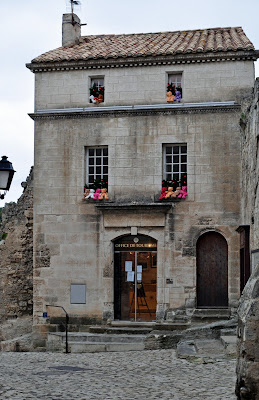We usually go to Mausanne or Mouries to buy bottles of the delicious olive oil that is produced in the Vallée des Baux and to buy wine and riz de Camargue - red rice produced in the Camargue region, at Mas de Gourgonnier every time we are in Sablet.
Our route to the Alpilles and Vallée des Baux where this wonderful olive oil is produced usually takes us past Les Baux de Provence, an ancient fortress town that can be seen from far away; the defensive possibilities of the site are clearly evident.
One morning a few months back, my family having left for California, I went to Mausanne to pick up tins of olive oil pressed from the 2010 harvest just a few weeks earlier. When I finished, I headed for Les Baux de Provence, figuring there wouldn't be too many visitors at that time of year and I could find parking close to the entrance to the village.
Les Baux de Provence is a very picturesque village about 75 kms southwest of our house in Sablet. The village sits in a spectacular site on a rocky outcrop with ancient houses and a ruined castle perched on top of the village overlooking the plains to the south. The road to Les Baux from the south takes you past olive groves and vineyards.
The village is officially classified as one of the Les Plus Beaux Villages de France - one of the most beautiful villages of France. The beauty of the village and surrounding Alpilles, a small range of mountains, makes Les Baux de Provence a very popular place for visitors all year long.
The name Les Baux refers to its site - in Provençal, a baou is a rocky spur. Aluminum ore bauxite was first discovered near Les Baux in 1822 and named after the village of Les Baux de Provence. Bauxite was mined extensively in the area but by the end of the 20th century, the bauxite had been completely removed.
You have to pay to park your car near the village but parking is allowed for free along the road leading up to the village. Just inside, is the Maison du Roy - King's House, built in 1499. The King's House is now the home of the Office de Tourisme - Tourist Office.
As I mentioned earlier, the village of Les Baux de Provence sits on a rocky outcrop overlooking the plains to the south. The view is fabulous and it looks like it would have been very difficult for enemies to sneak up on the villagers.
The Musée des Santons - the museum of santons (santons are plaster-moulded, kiln-fired nativity figurines dressed in traditional Provençal costumes) contains a large number of exhibits including some figurines made in Naples, scenes illustrating the traditions of Provence and Les Baux linked to the Nativity and a documentary film on the manufacture of these figurines.
You can't drive through Les Baux de Provence as cars are prohibited so the village must be visited on foot.
As I walked around, I discovered that Les Baux de Provence is crisscrossed by narrow cobblestone streets lined with art galleries, cafés and shops selling souvenirs and products made in Provence.
One of the many narrow cobblestone streets.
I came across some beautiful old houses and facades.
Another narrow street and tourist shop.
The 12th-century L'église Saint-Vincent building is typical of construction in Les Baux with the church's southern section built half into the rock.
La Chapelle des Penitents Blancs on Place de l'église, was built in the mid-17th century by the Brotherhood of White Penitents. The chapel stands on the edge of the cliff overlooking the Fontaine Valley.
This graceful stone campanile, so-called lantern of the dead, flanks the north side of L'église Saint-Vincent.
A shop selling souvenirs from Provence; the streets were mostly deserted early in January except for a dog keeping watch. It was very different when I returned with friends in April.
One more cobblestone street to explore as I headed back to the parking lot and my car.
The day was overcast and cool the day I visited so I didn't walk to the castle ruins as I remembered going there in January several years before when the Mistral (strong cold wind) was blowing and it was bitter cold; so I decided to take a pass that day.
I did go to Les Baux de Provence and up to the castle ruins a few weeks ago with friends which I will tell you about in a future post. Bonne journée et à bientot.














I love Les Baux. I always send tourists there and I always stop for olive oil on the way, too :)
ReplyDeleteLes Beaux is beautiful and more so out of season. Shame that they closed the "Cathédrale d'Images" in the old quarry -did you go there when it was still open?.
ReplyDeleteMeredith - I think Les Baux and the area around Les Baux is beautiful and look forward to return visits.
ReplyDeleteBarbara - Unfortunately, we never made it to Cathédrale d'Images but have seen some pictures; wish we could have seen it for real. I sort of shy away from Les Baux in the summer as I hate to deal with parking and the crowds.
Hi Michel! Your description and pics remind me of all those marvellous villages in the area! We tried to visit Les Baux a couple of years ago but it was absolutely packed and no place whatsoever to park so sadly we gave up. But we will try again - it looks great! Thanks for posting.
ReplyDelete